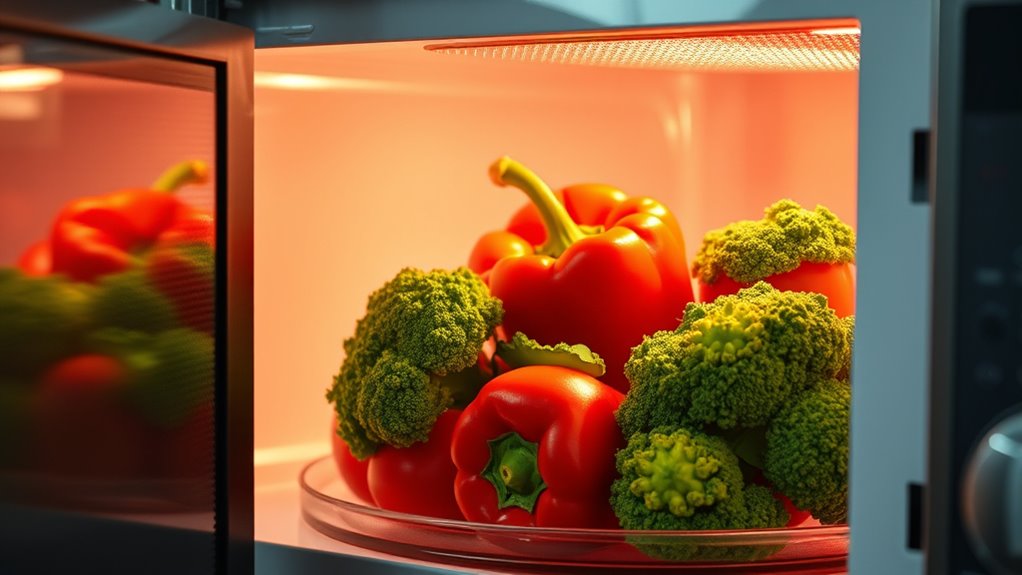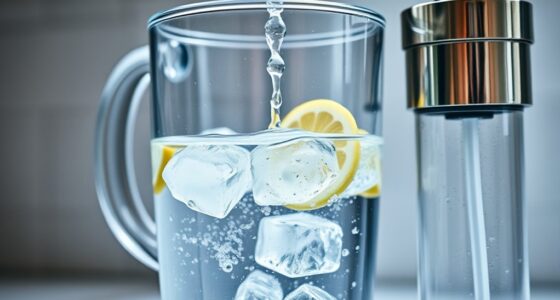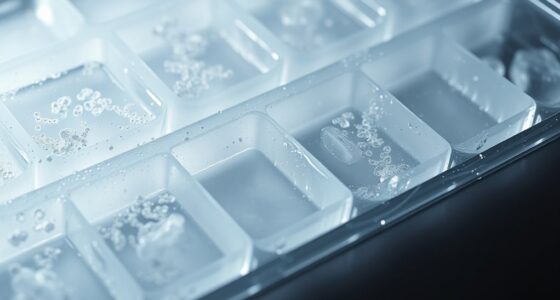Microwaves can secretly diminish your food’s nutrients if you overcook or use excessive water, which speeds up the breakdown of vitamins and antioxidants. Longer heating times and high temperatures increase nutrient loss, especially for heat-sensitive nutrients like vitamin C. Using too much liquid causes water-soluble vitamins to leach out. If you stick to quick, low-water methods, you can preserve more nutrients—continue exploring to learn how to maximize your microwave’s nutritional benefits.
Key Takeaways
- Overcooking in the microwave can cause significant loss of water-soluble vitamins like vitamin C and B vitamins.
- Using excessive liquid during microwave cooking can lead to nutrient leaching, reducing antioxidant and vitamin content.
- Prolonged microwave heating increases nutrient degradation, especially at higher temperatures, harming antioxidants and phytochemicals.
- Cooking with high power levels or extended times can push food temperature above safe levels, damaging heat-sensitive nutrients.
- Failing to cover food properly may cause uneven heating, overcooking, and unintended nutrient loss.
The Science Behind Microwave Cooking and Nutrient Retention
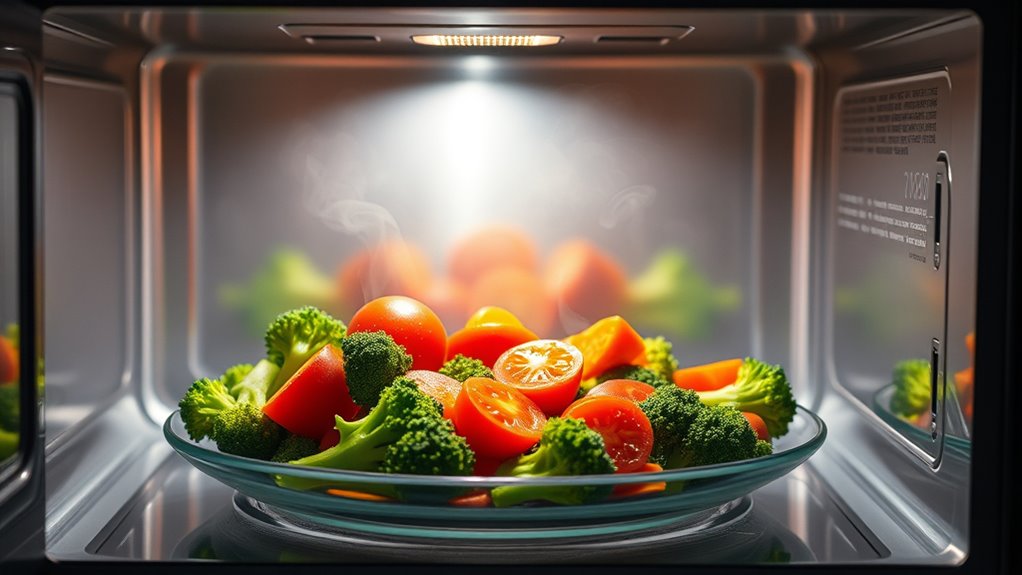
Microwave cooking heats food quickly by causing water, fats, and sugars to vibrate with electromagnetic waves, generating heat rapidly. This fast process helps minimize nutrient loss, especially for heat-sensitive nutrients like vitamin C and antioxidants, compared to a conventional oven. Because microwave heating is shorter and often at lower temperatures, it reduces the time nutrients are exposed to heat, preserving their structure. Unlike traditional methods that may cause leaching or overexposure, microwaves target water molecules directly, ensuring even heating without molecular damage. The chemical structure of nutrients remains largely intact during microwave cooking. As a result, vegetables cooked in a microwave often retain more nutrients than when boiled or fried, making it an effective method for nutrient preservation.
How Microwave Heat Affects Vitamins and Antioxidants
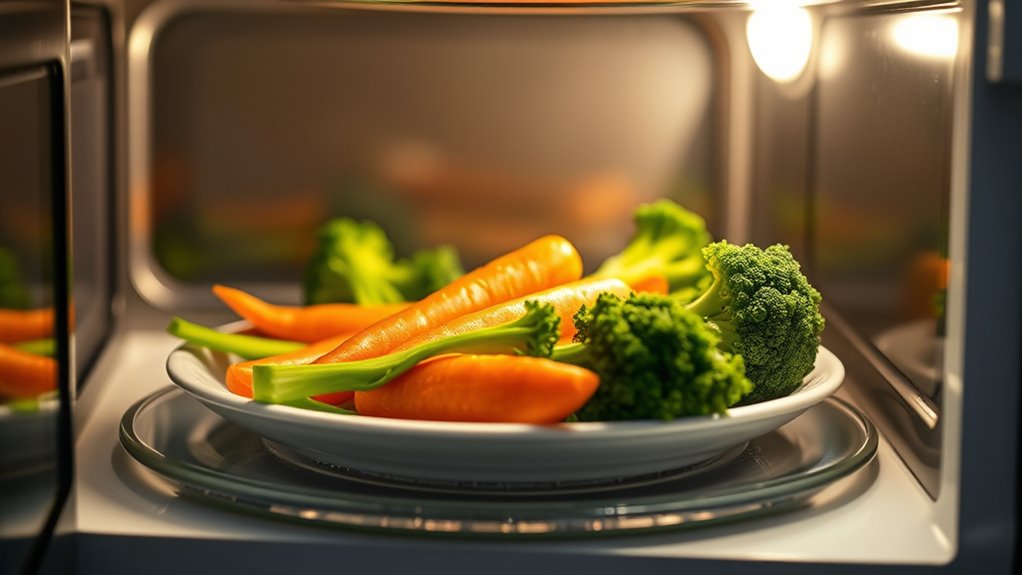
Because microwave heating uses short, controlled bursts of energy, it helps preserve heat-sensitive vitamins like vitamin C and B-complex nutrients more effectively than traditional cooking methods. The rapid heat transfer minimizes the time enzymes and antioxidants are exposed to high temperatures, reducing their breakdown. Studies show microwaving vegetables like broccoli retains higher levels of antioxidants, including flavonoids and carotenoids, compared to boiling or frying. Additionally, microwave cooking’s precise temperature control helps prevent nutrient degradation that can occur with prolonged heating. Proper microwave techniques, such as avoiding overcooking and using minimal water, are essential to prevent nutrient loss, especially water-soluble vitamins, through leaching and heat damage. To maximize nutrient retention, use minimal water and short cooking times. Ensuring proper techniques and understanding nutrient preservation can help maintain the beneficial antioxidants and vitamins, making microwave cooking a convenient way to retain nutrient quality. Properly timed microwave cooking can also help preserve enzymatic activity, which plays a role in nutrient stability. Incorporating appropriate cooking methods, such as steaming or using lower power settings, can further support nutrient retention. Additionally, choosing the right cooking methods can help preserve nutritional content, ensuring you get the most health benefits from your meals.
Common Myths About Microwaves and Food Damage
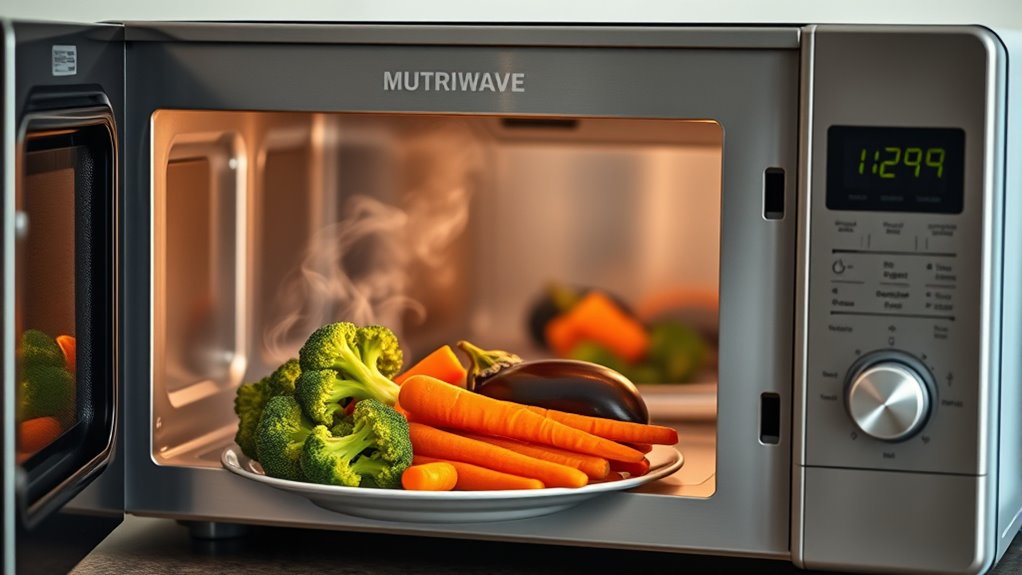
Many people believe microwaves damage nutrients more than other cooking methods, but research shows all techniques cause some nutrient loss. The idea that microwaves create harmful chemical changes is also a myth, since they use non-ionizing radiation that doesn’t alter food’s chemistry. In fact, shorter microwave cooking times can help preserve nutrients better than longer heating methods. Understanding microwave chemistry reveals that microwave radiation does not induce chemical changes in food, reassuring consumers about safety and nutritional integrity. Additionally, the non-ionizing radiation used in microwave ovens does not have enough energy to break chemical bonds or produce free radicals, further supporting their safety. It is also important to recognize that microwave safety studies consistently demonstrate no increased risk of chemical alterations in foods prepared with microwave radiation. Moreover, nutrient preservation techniques highlight that microwave heating can be more effective at retaining vitamins compared to traditional methods. In fact, research indicates that heat exposure duration plays a crucial role in nutrient retention across all cooking methods.
Microwaves Damage Nutrients
A common myth is that microwaving food destroys nutrients more than other cooking methods, but scientific evidence doesn’t support this claim. Microwaves use rapid heating at low temperatures, which actually helps preserve nutrients better than prolonged methods like boiling or frying. The quick process minimizes heat exposure, reducing vitamin and antioxidant loss. Studies show that nutrient destruction happens in all cooking techniques, and microwave cooking isn’t uniquely damaging. Overcooking or adding excessive water can leach water-soluble vitamins, but this isn’t an inherent flaw of microwaves. Instead, it’s about how you cook and preserve food. Proper cooking techniques and storage methods are essential for maintaining nutritional value. Additionally, the use of appropriate containers can prevent nutrient loss during microwave cooking. Incorporating proper heating practices can further help in retaining the nutritional content of foods. Using minimal water during cooking can also help preserve water-soluble vitamins. Overall, scientific research confirms that microwaves don’t damage or destroy nutrients more than other conventional cooking methods, making them a safe choice for preserving food’s nutritional value.
Myth: Food Loses Nutrients
One common myth is that microwaving food causes significant nutrient loss, but in reality, most nutrient degradation results from overcooking or high-heat methods rather than microwave use. When you microwave, you typically cook food quickly, which helps preserve water-soluble vitamins like vitamin C and B-complex. Unlike boiling, microwave cooking minimizes nutrient leaching into water, maintaining higher nutritional value. The belief that microwaves destroy nutrients more than other cooking methods is unfounded and unsupported by scientific evidence. To keep nutrients intact, use proper microwave techniques such as reducing cooking time and avoiding overheating. Additionally, controlling temperature and time plays a crucial role in how well the food’s colors and textures appear after cooking, impacting overall visual quality. Proper microwave use can also help prevent nutrient loss caused by overcooking, ensuring your food retains its essential vitamins and minerals. Implementing microwave efficiency techniques can further enhance nutrient preservation, making your meals both quick and nutritious. Here’s a quick picture:
- Overcooking releases nutrients.
- High-heat methods degrade vitamins.
- Microwaving preserves water-soluble vitamins.
- Proper techniques maximize nutrition.
Factors That Influence Nutrient Loss During Microwave Use
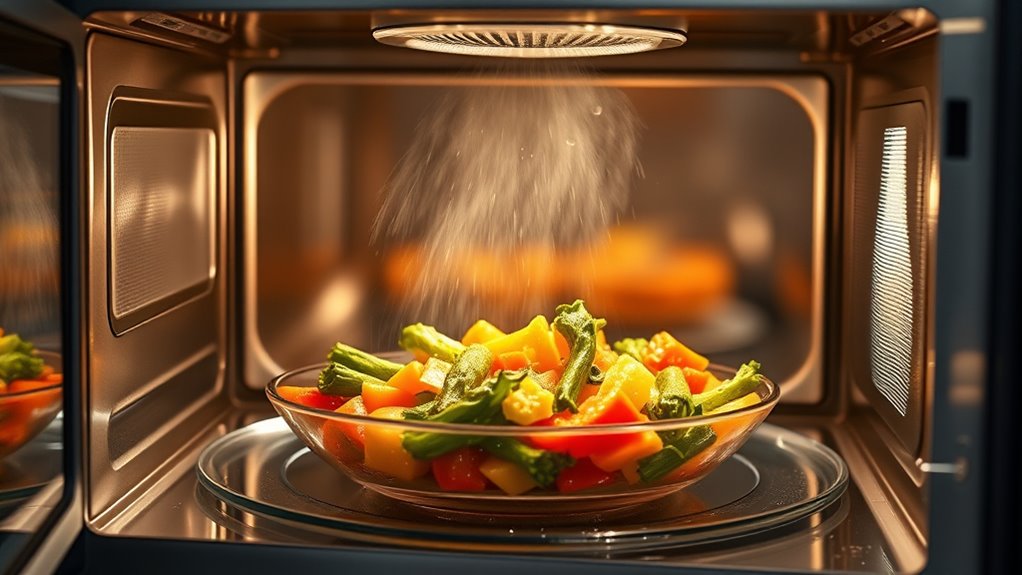
When you microwave food, the amount of time you cook it can considerably affect nutrient retention. Higher temperatures and longer durations often lead to greater nutrient loss, especially for heat-sensitive vitamins. Additionally, using too much water can wash away water-soluble nutrients, further reducing the food’s nutritional value. Incorporating sound vibrations into your cooking process can sometimes help preserve certain nutrients through gentle energy transfer. Employing appropriate cooking techniques can also minimize nutrient degradation during microwaving.
Cooking Duration Matters
The length of microwave cooking considerably impacts nutrient retention, with longer durations leading to greater nutrient loss. When you extend cooking times, especially in microwave heating, you risk losing essential food nutrients. For example:
- Longer cooking times cause up to 80% loss of water-soluble vitamins like vitamin C and B vitamins.
- Prolonged exposure increases nutrient degradation, even if the food starts at a cool temperature.
- Extended microwave heating can destroy antioxidants and phytochemicals.
- Overcooking can result in nutrient destruction comparable to boiling or oven roasting.
Temperature’s Impact on Nutrients
Higher microwave temperatures directly cause greater nutrient loss, especially for heat-sensitive nutrients like vitamin C and antioxidants. During microwave cooking, as the temperature rises, these nutrients break down more quickly. Longer cooking times increase the heat exposure, leading to significant nutrient deterioration. Excessive heating, particularly at high power, can push food temperatures above 212°F, accelerating chemical changes and nutrient destruction. To minimize nutrient loss, using lower microwave power settings and shorter cooking durations helps keep temperatures in a safer range. Rapid heating reduces the time nutrients are exposed to damaging heat, preserving more of their beneficial properties. Overall, controlling temperature during microwave cooking is essential to retain the maximum nutritional value of your food.
Liquid Quantity Effects
Using the right amount of liquid during microwave cooking considerably impacts nutrient retention. Too much liquid causes leaching, where water-soluble nutrients like vitamin C and B vitamins escape into the cooking water, reducing their presence in your food. Here’s what influences nutrient loss:
- Excessive liquid dilutes nutrients and promotes leaching, especially in vegetables rich in antioxidants.
- Minimal liquid or dry microwaving minimizes water contact, helping preserve water-soluble nutrients.
- Overwatering increases nutrient degradation through prolonged heat exposure and leaching.
- Using just enough liquid to generate steam or opting for dry microwave methods retains more nutrients by limiting leaching and heat exposure.
Comparing Microwave Cooking to Other Methods in Nutritional Preservation
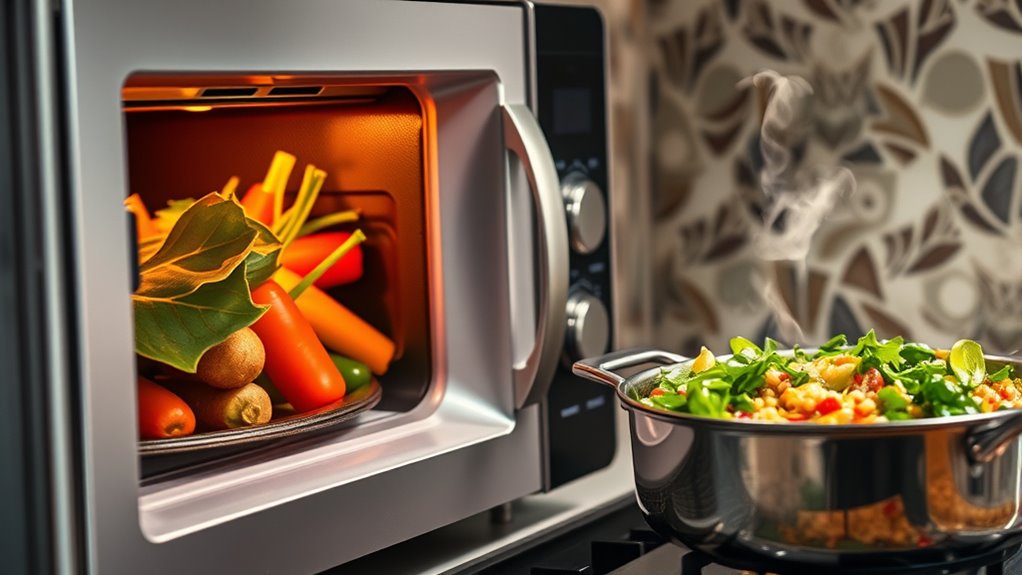
Compared to boiling or frying, microwave cooking often preserves more nutrients because of its shorter cooking times and reduced exposure to high temperatures. This quick process minimizes nutrient loss, especially for sensitive vitamins like C and antioxidants. Studies show that vegetables like broccoli and spinach retain more nutrients when microwaved than when oven-roasted or boiled. Using minimal water during microwave cooking prevents leaching water-soluble vitamins, further enhancing food preservation.
| Cooking Method | Nutritional Impact | Typical Nutrients Preserved |
|---|---|---|
| Microwave | Faster, less nutrient loss | Vitamin C, antioxidants |
| Boiling | Longer, more nutrient loss | Water-soluble vitamins |
| Frying | High heat, nutrient degradation | Fat-soluble vitamins |
Best Practices to Minimize Nutrient Degradation in Your Microwave
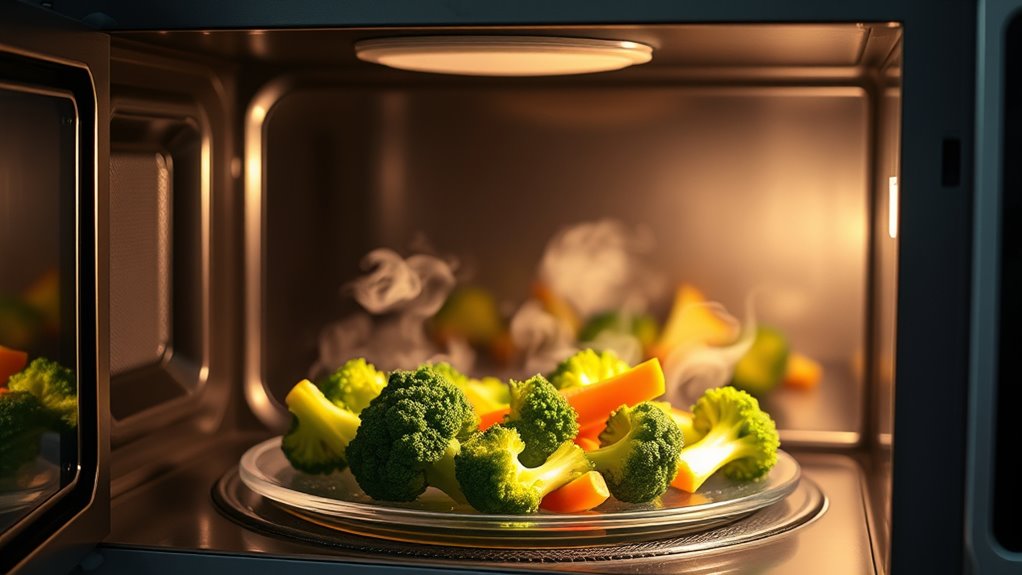
To minimize nutrient degradation when microwaving, it’s vital to follow some simple best practices. First, always use microwave-safe containers like glass or microwave-specific plastics to prevent chemical leaching that can harm food nutrients. Second, avoid overcooking by cooking in short bursts of 1-2 minutes, checking frequently to preserve water-soluble vitamins like vitamin C. Third, cover your food with a microwave-safe lid or vented plastic wrap to retain moisture, reducing nutrient loss during cooking. Finally, stir or rotate your food midway through microwaving to ensure even heating and prevent nutrient-destroying hot spots. Additionally, adding a small amount of water when microwaving vegetables helps preserve antioxidants and minimizes nutrient leaching into cooking liquids. These practices optimize nutrient preservation with your microwave.
Recognizing the Limitations and Safety Aspects of Microwave Food Preparation
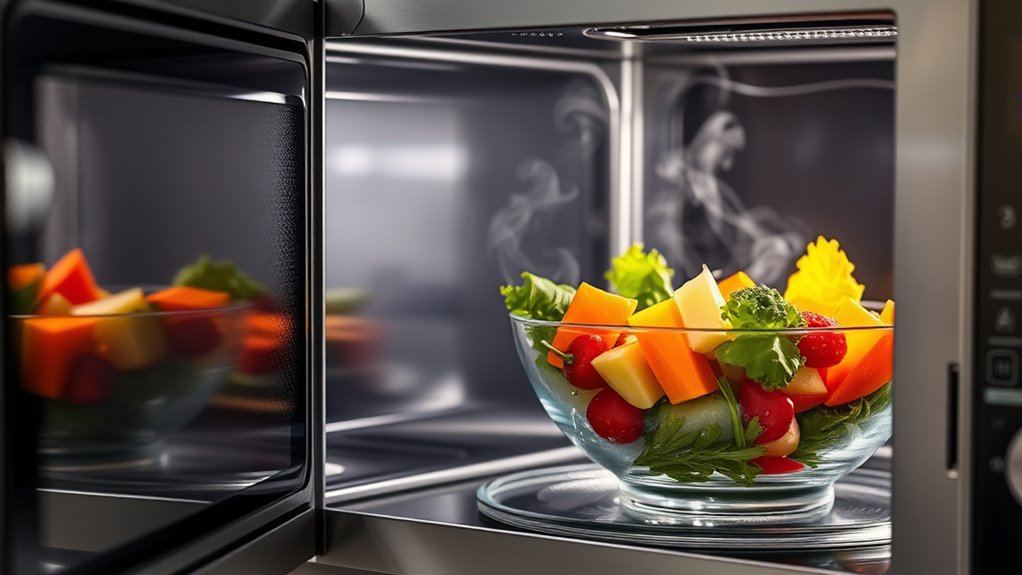
While microwaving is a convenient way to prepare food and helps preserve nutrients better than some other methods, it’s important to understand its limitations and safety considerations. Always use microwave-safe containers to prevent chemical leaching and guarantee proper use. Overcooking can lead to unnecessary nutrient loss, so avoid extended heating times. Proper heating techniques, like stirring food and using even power levels, help maintain nutrient integrity and ensure food safety. Be cautious with plastics; avoid heating in non-microwave-safe plastics to reduce chemical exposure. Remember, microwave cooking doesn’t inherently destroy nutrients more than other methods; rather, time and temperature influence nutrient loss. Recognizing these safety aspects ensures your food remains nutritious and safe to eat.
Frequently Asked Questions
Do Microwaves Destroy the Nutritional Value of Food?
You might wonder if microwaves destroy your food’s nutrients. The truth is, microwaving actually preserves more nutrients than boiling or frying because it cooks quickly at lower temperatures. If you avoid overcooking, your food retains most of its vitamins and antioxidants. Scientific evidence shows that microwave cooking doesn’t inherently damage nutrients more than other methods, so your food stays nutritious when you use your microwave properly.
What Are the Negative Effects of Microwaves?
When it comes to negative effects of microwaves, don’t put all your eggs in one basket. While microwaves don’t inherently harm nutrients, improper use can cause issues. Overheating foods or using non-microwave-safe plastics might lead to chemical leaching. Additionally, cooking fatty foods at high temps can produce harmful compounds. Use your microwave wisely, follow safety guidelines, and you’ll avoid most risks and keep your food healthy.
Is It Unhealthy to Reheat Food in the Microwave?
Reheating food in the microwave isn’t necessarily unhealthy, but it can pose risks if not done properly. You might lose some heat-sensitive nutrients like vitamins C and B, and uneven heating could leave bacteria alive, risking food poisoning. To stay safe, guarantee even heating, use microwave-safe containers, and don’t reheat food multiple times. Proper reheating preserves nutrients and reduces health risks.
Do Eggs Lose Nutritional Value When Microwaved?
When you microwave eggs, they generally retain most of their nutrients if you don’t overcook them. Short cooking times and lower heat help preserve proteins, vitamins, and minerals. However, if you microwave eggs too long or at high temperatures, some heat-sensitive nutrients like vitamin B12 and biotin may decrease slightly. To keep nutrients intact, pierce the eggs beforehand and avoid overheating, ensuring they stay nutritious and delicious.
Conclusion
While your microwave might seem like a quick, convenient friend, it can secretly chip away at your food’s essential nutrients, like a thief in the night. But with mindful use and smart practices, you can guard your meals’ vitality. Think of your microwave as a delicate dance partner—treat it with care, and it’ll help preserve the vibrant, nourishing essence of your food, keeping your meals as lively and wholesome as a sunrise.
